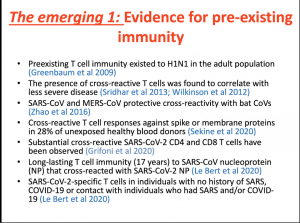The South African Immunology Society (SAIS) in collaboration with Immunopaedia hosted a webinar that featured talks by Prof Clive Gray and Dr Melinda Suchard on “What possible immune responses causes severe COVID-19 in some and recovery in most? “ and “Macrophage activation and Nicotinamide pathways in COVID-19”
Prof Clive Gray gave a tour de force overview on what we currently know about COVID-19 immunology. His talk focused on 4 main areas:
- Lessons learnt from SARS-CoV (MERS and other respiratory viral) research (etiological agent for the 2003/4 SARS epidemic). He showed that high viral inoculum (exposure) is associated with hyper inflammation which if left unchecked causes detrimental pathology.
- the balance between inflammation and tolerance (read: Tissue tolerance in COVID-19)
- An overview of multiple studies that hat demonstrates that hyper inflammation (increase in IL-8, TNF, IL-6, CXCL2) and infiltration innate cells (macrophages, monocytes and neutrophils) into the lung tissue results in tissue damage is associated with severe disease. Also read: Multi-organ damage is a hallmark of severe COVID-19; Are Lung microbial products driving hyper inflammation in severe COVID-19?
 He provided a summary of recent papers that suggest a role in T cell memory in reduced pathology. Also Read:
He provided a summary of recent papers that suggest a role in T cell memory in reduced pathology. Also Read:
Melinda Suchard (SAIS President) began her talk with a brief introduction of the role macrophages play in hyperinflammatory syndrome (also known as “cytokine storm”) and the potential role of macrophage activation syndrome in patients with severe COVID-19. She then described the different pathways of macrophage activation (alternative vs classical macrophage activation) and metabolism (oxidative phosphorylation vs Warburg-like (aerobic glycosylation) metabolism). Why was this important? She described that upon during infection macrophages switch to a Warburg-like metabolism which results in an increase in TNF, while glycolysis is associated with an increase in anti-inflammatory cytokines like IL-10. Thus highlighting a role of macrophage metabolism in their effector function. For example indoleamine 2,3 dioxygenase (IDO) activity which catalyses nicotinamide is usually associated with alternatively activated macrophages. She then highlighted that COVID-19 risk factors: age, diabetes, obesity, hypertension & gender are associated with disruption of the Nicotinamide adenine dinucleotide (NAD) metabolism. Based on this researchers hypothesise that “infectious pathogens (including SARS-CoV-2) may cause disruptions in the NAD pathway” and pre-existing disruptions in chronic diseases that also affect NAD metabolism such as the COVID-19 risk factors described above results in diseases severity upon infection. Finally, she ended her talk providing evidence from other viral diseases and sepsis and that support this hypothesis and the potential role of NAD metabolism in understanding pathology of COVID-19 and other viral associated Sepsis.
Summary by Cheleka Mpande










